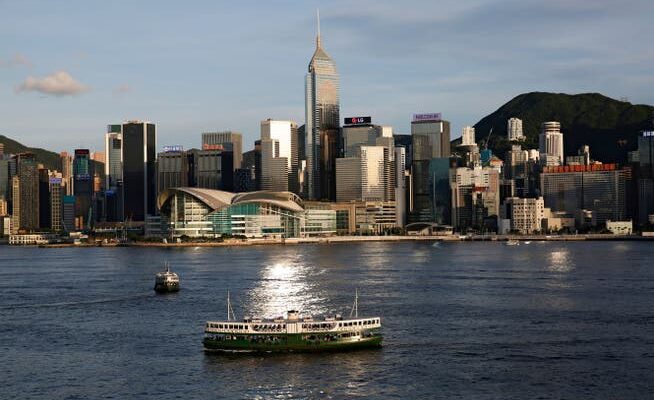After the borders were opened, Hong Kong in particular is hoping for tourists from mainland China. But so far, visitors have only come in droplets.
Before the outbreak of the pandemic, Hong Kong was one of the most popular tourist destinations for Chinese people. After the border was opened, the expected large flow of visitors has not materialized so far.
It’s been five days since China’s government lifted the last travel restrictions. In particular, the mandatory eight-day hotel quarantine to contain the pandemic has kept many people from traveling to China in recent years. This quarantine has been history since last Sunday – but there is no sign of a travel boom.
For example, at the Lok Ma Chau border crossing in Hong Kong, one of the most important entry and exit points between the former British crown colony and China before the outbreak of the pandemic, only a few people could be seen on Wednesday afternoon this week. Across a narrow river that forms the border between Hong Kong and China, the view extends across to the skyline of the Chinese tech metropolis Shenzhen. From here it is only a few meters to China.
The only people standing at the passport control desk are an elderly couple, a man traveling alone and a young Chinese woman studying in Hong Kong. “Of course, the abolition of the quarantine is a huge relief,” says the student. Now she wants to visit her parents in Shenzhen. The flow of visitors is also extremely sparse in the opposite direction. The train that drives from the border crossing to downtown Hong Kong is almost deserted. Hong Kong had already lifted the last corona restrictions in December,
The pandemic is raging in China
There are several reasons why the big travel boom has not materialized so far. On the one hand, the corona virus is raging in large parts of China. That should keep many people from traveling to the Middle Kingdom. On the other hand, despite the lifting of travel restrictions, there are still only a few flights to China. Last Sunday, the display board at China’s capital airport showed only eight international flights between 9 a.m. and 2 p.m. the following day. Four of these went to Hong Kong and Macau Special Administrative Regions.
The Lufthansa Group, with its companies Austrian Airlines and Lufthansa, currently only offers six flights a week between China and Europe. However, the group plans to increase the number of frequencies in the near future, as a spokeswoman in Shanghai announced on request.
There are also political frictions. Because China’s abrupt departure from the zero-Covid policy has led to a dramatic wave of infections in the country, numerous countries are requiring travelers from China to have a negative test, even if the scientific benefit of this procedure is extremely controversial. Many European countries are also reluctant to issue visas to Chinese people. This, in turn, causes dissatisfaction with the Chinese government.
Dispute over visas between China, South Korea and Japan
Especially between China and South Korea as well as Japan, the dispute over the entry procedure has recently escalated. After South Korea initially suspended issuing entry visas to the Chinese until January 31, Beijing is now striking back. The Chinese Embassy in Seoul will no longer issue tourist, business and transit visas until further notice. Beijing’s representation in Tokyo has also suspended visas.
“Unfortunately, a small number of countries insist on discriminatory entry restrictions against China,” said a Chinese Foreign Ministry spokesman on Tuesday. The countries, the spokesman continued, ignored the scientific facts and the pandemic situations in their homes.
Hong Kong is particularly disappointed with the lack of a wave of travel from China. Between Sunday and Tuesday afternoon, 4 p.m., just under 40,000 visitors from mainland China came to the former British colony overland. The new regulations stipulate that 50,000 visitors from China may enter Hong Kong per day. On average, only 26 percent of the daily quota has been used so far. In the opposite direction, the flow of visitors is greater.
Hong Kong’s tourism sector, which has been hit hard in recent years, has high hopes for travelers from mainland China. Before the pandemic, tourists from China had ensured steadily increasing sales at Hong Kong’s hotels, retailers and restaurants. Hong Kong wants to build on these times.
Hoping for the Chinese New Year
The city of 7.5 million is now hoping for the big rush for Chinese New Year on January 22nd. “The number of visitors will increase significantly there,” says Peter Lam, deputy director of the Hong Kong Trade Development Council, with conviction. The government-related association is responsible for Hong Kong’s location marketing. The travel regulations that are now in force are still quite new, says Lam, and it will take some time before more visitors come to Hong Kong. In addition, travel agencies in mainland China have not yet started organizing group tours to Hong Kong again.
After all, the abolition of quarantine regulations in China brings great relief for countless families, some of whom have been separated for years. Last Sunday, Kelly Kwok drove to Shenzhen with her mother to visit her grandparents. The 25-year-old from Hong Kong had not seen her grandparents for three years. The 79-year-old grandmother was in the hospital with Covid, but is on the mend.
Eventually, Kwok and her mother met grandfather for dinner. It wasn’t long before the mother was overcome by her feelings: so moved at seeing her father again after three years, she burst into tears.
